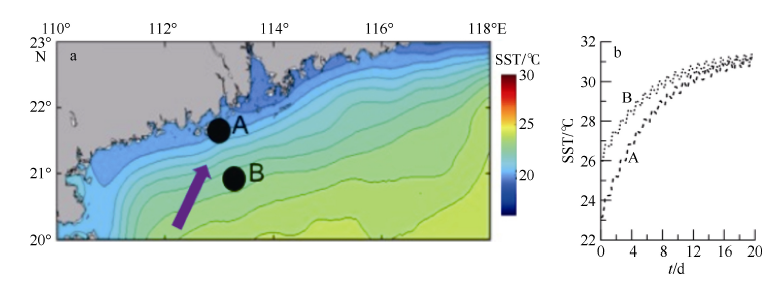| [1] |
陈俊昌, 1983. 南海北部冬季海面温度实时分布特征的若干解译[J]. 海洋学报, 5(3): 391-395.
|
| [2] |
李立, 郭小钢, 2000. 台湾海峡南部的海洋锋[J]. 台湾海峡, 19(2): 147-156.
|
|
LI LI, GUO XIAOGANG, 2000. Oceanic fronts in southern Taiwan Strait[J]. Journal of Oceanography in Taiwan Strait, 19(2): 147-156.
|
| [3] |
刘秦玉, 李薇, 徐启春, 1997. 东北季风与南海海洋环流的相互作用[J]. 海洋与湖沼, 28(5): 493-502.
|
|
LIU QINYU, LI WEI, XU QICHUN, 1997. Interaction between the northeast monsoon and ocean circulation in South China Sea[J]. Oceanologia et Limnologia Sinica, 28(5): 493-502 (in Chinese).
|
| [4] |
罗琳, 王东晓, 刘赟, 等, 2003. 北部湾温度锋的季节与年际变化[J]. 热带海洋学报, 22(4): 60-67.
|
|
LUO LIN, WANG DONGXIAO, LIU YUN, et al, 2003. Seasonal and interannual variabilities of thermal fronts in Beibu Gulf, South China Sea[J]. Journal of Tropical Oceanography, 22(4): 60-67 (in Chinese).
|
| [5] |
邵连军, 张红雷, 张春华, 等, 2015. 基于海温遥感资料的海洋锋检测方法[J]. 海洋测绘, 35(2): 42-44, 51.
|
|
SHAO LIANJUN, ZHANG HONGLEI, ZHANG CHUNHUA, et al, 2015. A method for detecting the oceanic front using remotely sensed sea-surface temperature[J]. Hydrographic Surveying and Charting, 35(2): 42-44, 51 (in Chinese).
|
| [6] |
王磊, 2004. 南海北部陆架区域的海洋锋及锋面涡旋研究[D]. 青岛: 中国海洋大学.
|
|
WANG LEI, 2004. A study of fronts and frontal eddies in the northern shelf region of the South China Sea[D]. Qingdao: Ocean University of China (in Chinese).
|
| [7] |
薛存金, 苏奋振, 周军其, 2007. 基于小波分析的海洋锋形态特征提取[J]. 海洋通报, 26(2): 20-27.
|
|
XUE CUNJIN, SU FENZHEN, ZHOU JUNQI, 2007. Extraction of ocean fronts based on wavelet analysis[J]. Marine Science Bulletin, 26(2): 20-27 (in Chinese).
|
| [8] |
杨海军, 刘秦玉, 1998. 南海上层水温分布的季节特征[J]. 海洋与湖沼, 29(5): 501-507.
|
|
YANG HAIJUN, LIU QINYU, 1998. The seasonal features of temperature distributions in the upper layer of the South China Sea[J]. Oceanologia et Limnologia Sinica, 29(5): 501-507 (in Chinese).
|
| [9] |
赵宝宏, 刘宇迪, 赵加华, 等, 2011. 南海海洋锋季节分布特征初探[C]//第28届中国气象学会年会——S17第三届研究生年会. 厦门: 中国气象学会: 1-16.
|
| [10] |
朱凤芹, 谢玲玲, 成印河, 2014. 南海温度锋的分布特征及季节变化[J]. 海洋与湖沼, 45(4): 695-702.
|
|
ZHU FENGQIN, XIE LINGLING, CHENG YINHE, 2014. Distribution and seasonal variations of temperature front in the South China Sea[J]. Oceanologia et Limnologia Sinica, 45(4): 695-702 (in Chinese).
|
| [11] |
庄伟, 2004. 粤东和越南沿岸上升流的分布特征及形成机制[D]. 厦门: 厦门大学.
|
|
ZHUANG WEI, 2004. Study of distribution and generating mechanism of eastern Guangdong and Vietnam Coastal upwelling[D]. Xiamen: Xiamen University (in Chinese).
|
| [12] |
BELKIN I M, CORNILLON P C, SHERMAN K, 2009. Fronts in large marine ecosystems[J]. Progress in Oceanography, 81(1-4): 223-236.
|
| [13] |
DONLON C J, MARTIN M, STARK J, et al, 2012. The operational sea surface temperature and sea ice analysis (OSTIA) system[J]. Remote Sensing of Environment, 116: 140-158.
|
| [14] |
GAN JIANPING, LI LI, WANG DONGXIAO, et al, 2009. Interaction of a river plume with coastal upwelling in the northeastern South China Sea[J]. Continental Shelf Research, 29(4): 728-740.
|
| [15] |
JING ZHIYOU, QI YIQUAN, DU YAN, et al, 2015. Summer upwelling and thermal fronts in the northwestern South China Sea: Observational analysis of two mesoscale mapping surveys[J]. Journal of Geophysical Research: Oceans, 120(3): 1993-2006, doi: 10.1002/2014JC010601.
|
| [16] |
JING ZHIYOU, QI YIQUAN, FOX-KEMPER B, et al, 2016. Seasonal thermal fronts on the northern South China Sea shelf: Satellite measurements and three repeated field surveys[J]. Journal of Geophysical Research: Oceans, 121(3): 1914-1930.
|
| [17] |
OLSON D B, HITCHCOCK G L, MARIANO A J, et al, 1994. Life on the edge: marine life and fronts[J]. Oceanography, 7(2): 52-60.
|
| [18] |
OU SUYING, ZHANG HONG, WANG DONGXIAO, et al, 2007. Horizontal characteristics of buoyant plume off the pearl river estuary during summer[J]. Journal of Coastal Research, 23(1): 652-657.
|
| [19] |
QIU CHUNHUA, WANG DONGXIAO, KAWAMURA H, et al, 2009. Validation of AVHRR and TMI-derived sea surface temperature in the northern South China Sea[J]. Continental Shelf Research, 29(20): 2358-2366.
|
| [20] |
QIU CHUNHUA, WANG DONGXIAO, HE ZHIGANG, et al, 2012. Seasonal variability of chlorophyll a fronts in the Luzon Strait based on satellite observations[J]. Aquatic Ecosystem Health & Management, 15(1): 46-52.
|
| [21] |
QIU CHUNHUA, KAWAMURA H, MAO HUABIN, et al, 2014. Mechanisms of the disappearance of sea surface temperature fronts in the subtropical north Pacific Ocean[J]. Journal of Geophysical Research: Oceans, 119(7): 4389-4398.
|
| [22] |
QIU CHUNHUA, CUI YONGSHENG, REN JIE, et al, 2016. Characteristics of the surface mixed layer depths in the northern south china sea in spring[J]. Journal of Oceanography, 72(4): 567-576.
|
| [23] |
SHIMADA T, SAKAIDA F, KAWAMURA H, et al, 2005. Application of an edge detection method to satellite images for distinguishing sea surface temperature fronts near the Japanese coast[J]. Remote Sensing of Environment, 98(1): 21-34.
|
| [24] |
WANG DONGXIAO, LIU YUN, QI YIQUAN, et al, 2001. Seasonal variability of thermal fronts in the northern South China Sea from satellite data[J]. Geophysical Research Letters, 28(20): 3963-3966.
|
| [25] |
YUAN JINNAN, WANG DONGXIAO, LIU CHUNXIA, et al, 2016. Validation of microwave-infrared, tropical rainfall measuring mission microwave imager and advanced microwave scanning radiometer-earth observing system and WindSat-derived sea surface temperatures in coastal waters of the northern South China Sea[J]. Aquatic Ecosystem Health & Management, 19(3): 260-269.
|
 ), Yongsheng CUI, Shiqi HU, Dan HUO
), Yongsheng CUI, Shiqi HU, Dan HUO

















